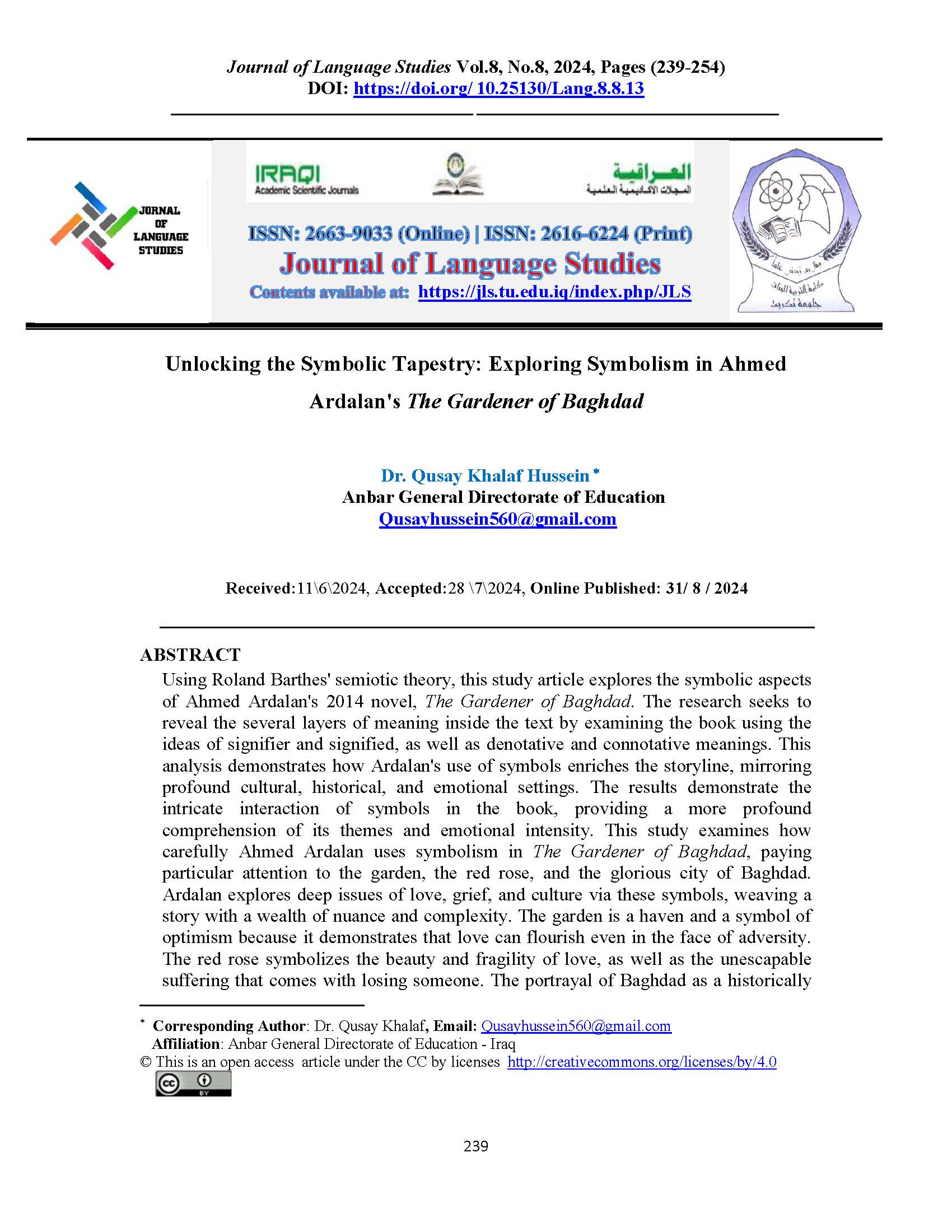Unlocking the Symbolic Tapestry: Exploring Symbolism in Ahmed Ardalan's The Gardener of Baghdad
DOI:
https://doi.org/10.25130/Lang.8.8.13Keywords:
Ahmed Ardalan, Barthes, Semiotics, symbolism, signifier and signified, denotative and connotative, the Gardener of BaghdadAbstract
Using Roland Barthes' semiotic theory, this study article explores the symbolic aspects of Ahmed Ardalan's 2014 novel, The Gardener of Baghdad. The research seeks to reveal the several layers of meaning inside the text by examining the book using the ideas of signifier and signified, as well as denotative and connotative meanings. This analysis demonstrates how Ardalan's use of symbols enriches the storyline, mirroring profound cultural, historical, and emotional settings. The results demonstrate the intricate interaction of symbols in the book, providing a more profound comprehension of its themes and emotional intensity. This study examines how carefully Ahmed Ardalan uses symbolism in The Gardener of Baghdad, paying particular attention to the garden, the red rose, and the glorious city of Baghdad. Ardalan explores deep issues of love, grief, and culture via these symbols, weaving a story with a wealth of nuance and complexity. The garden is a haven and a symbol of optimism because it demonstrates that love can flourish even in the face of adversity. The red rose symbolizes the beauty and fragility of love, as well as the unescapable suffering that comes with losing someone. The portrayal of Baghdad as a historically and culturally significant city embodies the people's tenacity and enduring spirit. This study reveals how these symbols are more than just literary devices—rather, they are crucial components that raise the novel's thematic depth. By unraveling this symbolic tapestry, the research provides a better understanding of Ardalan's reflection on the human condition, demonstrating the enduring significance of his writing.
References
Abdulridha, S. A., & Abdulridha, A. A. (2021). Symbolic Artistry in Dan Brown’s Angels and Demons. Journal of Language Studies, 4(2), 8-17.
Ahmad, B. K., & Shakir, L. I. (2023). Love and War in Ahmad Ardalan’s the Gardener of Baghdad. Migration Letters, 20(S7), 351-367.
Ardalan, A. (2014). The Gardener of Baghdad. Create Space Independent Publishing Platform.
Barthes, R. (1957, September). Histoire et sociologie du vêtement: quelques observations méthodologiques. In Annales. Histoire, Sciences Sociales (Vol. 12, No. 3, pp. 430-441). Cambridge University Press.
Barthes, R. (1968). Elements of semiology (Vol. 4). Macmillan.
Collective, W. R. (2015). Combined and uneven development: Towards a new theory of world-literature (Vol. 17). Oxford University Press.
Cuddon, J. A. (1998). A dictionary of literary terms and theory.
dan Stork, H. R. (1972). A Dictionary of Linguistik.
de Saussure, J. (Ed.). (1915). Ferdinand de Saussure:(1857-1913). La Gazette de Lausanne.
Eco, U. (1976). Peirce's notion of interpretant. MLN, 91(6), 1457-1472.
Fisk, J. E., & Pidgeon, N. (1998). Conditional probabilities, potential surprise, and the conjunction fallacy. The Quarterly Journal of Experimental Psychology Section A, 51(3), 655-681.
Hamad, H. S. (2020). The Use of Symbolism in Hemingway's The Old Man and the Sea. journal of Language Studies, 4(1), 115-125.
Jackson, K. S. (2023). Interpretive Strategies: Unraveling Symbolism in TS Eliot’s The Hollow Men. Modernist Cultures, 36(4), 567–589.
Jamieson, H. (2008). Forming art: making and responding. Journal of Visual Art Practice, 7(1), 75-84.
Krajka, J. (2001). Oxford Advanced Learner’s CD-ROM Dictionary. Teaching English with Technology, 1(5), 23-30.
Muhammad, M. A. (2022). The Use of Semiotic Choices in Social Media. journal of Language Studies, 6(1), 413-423.
Park, I.-K. (2016). Literary Therapeutic Mechanism Analysis in which the Rated Sijo is Encoded as a Battery of Life. International Journal of Advanced Culture Technology, 4(4), 45–50.
Sebeok, T. A. (2001). Signs: An introduction to semiotics. University of Toronto Press.
Van Rees, C. (1984). ‘Theory of literature’viewed as a conception of literature. On the premises underlying Wellek and Warren’s handbook. Poetics, 13(6), 501–533.
Zimmer, H. (2013). Philosophies of India. Routledge.

